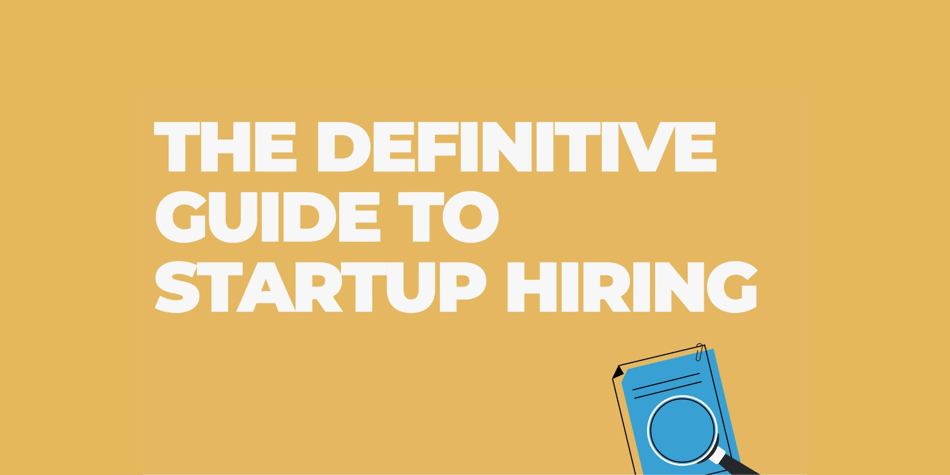If people are your greatest asset, then finding the right people early on should be your number one goal as you start the year.
The past two years have shown that the competition for talent is tighter than ever.
“The market for top talent has never been more competitive nor more important. Talent is likely to be the number one challenge entrepreneurs face in 2022. Startups and their boards must develop talent strategies earlier and then back those strategies with the funding to attract and retain the talent needed to execute on the business plan,” Tom Walker, Rev1 Ventures CEO, said in their annual startup predictions.
And a tight labor market allows top candidates to be picky. But don’t fret. In the long run, it’s really a good thing. When they choose your company, it means they really want to be there.
But how do you get them to choose you? How do you even source top talent in today’s tight labor market? And what if you’re not raising tens of millions of dollars to attract candidates?
We’re breaking down the top hiring strategies that startups can use to start 2022 off right. Want a little extra help? Chat with our team to get an employer brand game plan — and a team to do the heavy lifting.
Startup Recruiting Strategies for 2022
1. Focus on your employer brand
Just as they would before they make a big purchase, candidates do their own research about potential employers. They’re reading reviews on Glassdoor, looking up existing team members on LinkedIn, reading up on media coverage, and browsing through social media profiles on platforms like Stack Overflow.
And just as marketers try to sell products or services, startups should be marketing their company to candidates. It’s all about highlighting your employer brand.
Put simply, your employer brand is your company’s personality and reputation. It’s the attributes that characterize your culture. It’s what people say about your organization behind the scenes and how your team feels working there.
A good employer brand (and brand awareness) goes a long way, because candidates are excited about working at the company and are knocking on your door for the chance.
For startups, employer branding is all the more important, since you might not be able to rely on name recognition, company history, or stability… yet. Just because your company is new and small doesn’t mean it’s risky working there. Instead, you want to convince candidates that NOT working there is a risky career decision!
There are many tools you can use to show off your employer brand:
1. Any hiring-focused blogs, events, or communication programs
2. Videos and photos you share publicly
3. Employee Spotlights on LinkedIn, Twitter, etc.
Tell authentic stories (and don’t forget the old “show, don’t tell”) about what it’s like to work at your company, and clearly share your vision and purpose. Candidates are looking for employers that are mission-driven, treat their employers well, and are great places to work.
By helping candidates picture themselves working at your company, they’ll feel invested based on shared values, and ready to be in it for the long haul.
If you’re looking for some specific employer branding tips, keep reading. We got lots of them.
2. Build DEI into your plan from the start
It’s imperative that you remain focused on your DEI hiring strategies as well as your larger DEI goals. COO of Rev1 Ventures, Kristy Campbell, said that startups should be building DEI strategies into their business plan from day one.
“It’s a fact: companies with diverse leadership teams are more successful, so making DE&I a priority gives the company a leg up. This starts with the founding team, who must believe in and live out the culture in their daily actions. From the hiring process to the customer experience, DE&I principles should influence the company’s priorities and decisions,” Kristy said.
So how do you do it? The first step is to set goals, and then build a step by step plan that will help you achieve those goals.
When it comes to hiring strategies, it’s important to make sure you’re sourcing talent from diverse backgrounds. If diverse candidates aren’t coming to you, you have to put in the extra work to find them. Here are some quick tips for sourcing talent from diverse backgrounds:
1. Join a role-specific community
2. Host an event
3. Open up referral networks – good people know good people
4. Join social media groups and chats
Remember that diversity comes in many forms: race, gender, sexual orientation, age, ability, education, background, etc.
Another thing you’ll want to do if you notice you don’t have many diverse candidates applying is to rethink your job descriptions. Do they use inclusive language? Do the requirements alienate people who didn’t have access to the same opportunities and education as others?
Lastly, once you do get diverse candidates applying, make sure your interview process is designed in an equitable way. Ask the same questions that you ask everyone applying for the role. Create a scale to remove bias. Screen candidates blindly. Consider potential more than previous achievements.
3. Use Videos
There’s no getting around it. The world loves videos (hey, thanks for reading this blog). While you don’t have to be on TikTok (though it seems to be working for Duolingo), there are some key ways you can incorporate video into your hiring strategy.
One thing the Purpose Jobs team loves to do is use VideoAsk to easily collect quick employee testimonials to share on an organization’s company profile (here’s RoboTire's company page for example). An employee can quickly record themselves sharing a bit about why they like their job or the company, what kinds of things they get to work on, or a benefit they especially love. They’re extra great because they’re not overly polished, just people being humans.
Here's an example from Dynatrace:
You can also use videos to highlight your office, share more about your company culture, highlight your founder with a quick interview, or do an “actor on actor” interview between your employees.
The options are endless, and you don’t need thousands of dollars worth of equipment. Just a camera and some great humans.
4. Follow a clear process (and use it on every candidate)
An important startup hiring concept to understand is the recruiting life cycle. Each organization is different, but every one will need to provide structure and guidance to every candidate being recruited, and it should follow the same process each and every time.
Think of your company’s recruiting lifecycle as an extension of your company culture. With every touchpoint, you’re extending an invitation that says, “Hey, join us!” Make sure that your candidate feels valued and welcomed. Processes are, by definition, rigid. Culture helps fill in the gaps to humanize your company.
The startup recruiting process includes…
1. Preparation
2. Sourcing Talent
3. Screening
4. Selecting
5. Hiring
6. Onboarding
For a detailed step-by-step process, check out the Purpose Jobs x Optimist Startup Hiring Guide.
5. Showcase your humans
This goes hand in hand with your employer branding. Candidates' bullshit detectors are really sensitive, and they don’t want to see a bunch of overly polished videos of employees fake laughing at an awkward company picnic.
The best way for you to help candidates picture themselves being a part of the company is to showcase your current humans being their own authentic selves. Sounds counterintuitive, but the more detailed you get, the more universal it becomes.
People want to work with great people. So show off your great humans. Like I said, they’re your greatest asset.
Here's a fun example from Detroit startup Qodex. The team went skiing. It's a great photo because it shows the team having fun, it's not overly posed, and it lets candidates know that the team does fun things together.

6. Build a talent pipeline with a waiting list
Marketers use this trick all the time: build buzz and anticipation before a product launch with a waitlist. You can do the same with a job.
If you don’t have many roles open right now, create a job description waitlist to build a pipeline of interested candidates. Chances are, they want to work for your company and don’t care as much about the details of the job (and that’s a good thing!).
Collect their emails, nurture them through the recruiting process, and make sure to let them know when you post more jobs. They might be some of the first candidates to apply.
For more job description tips, check out the complete guide to startup hiring.
7. Be competitive with salaries and benefits
A good salary is always pretty high up there on a candidate’s wish list. While your mission and values matter a lot, you can’t let them do all the work when it comes to salary and benefits.
If you can’t pay people competitively, you will struggle to find top tech candidates. But there are ways you can compensate employees if you can’t pay top dollar.
-
Give generous PTO — and make sure you have a culture that encourages people to take time off
-
Offer equity in the company — this is becoming more common in startups, but candidates who get in early at the company might find some huge financial benefits down the road
-
Build out benefits that matter: health insurance, paid parental leave, flexible work arrangements, home office stipends
-
Cover professional learning opportunities — have a budget set aside for your employees to grow and learn
Additionally, if you’re hiring from across the country (or even across the globe), it might be helpful to provide candidates with a breakdown of salary and cost of living comparisons.
If top candidates are comparing an Ann Arbor tech salary to a San Francisco one, they might be disappointed at first glance. But when they compare how cheap it is to live in Michigan, they’ll see that working in the Midwest is a much better financial decision. Provide housing costs, average rent and grocery prices, healthcare costs and more. It can help candidates see the whole picture a lot more clearly.
Have no time to do this? Purpose Jobs can help. We'll build your strategy, and create custom content for you. Get started now.









